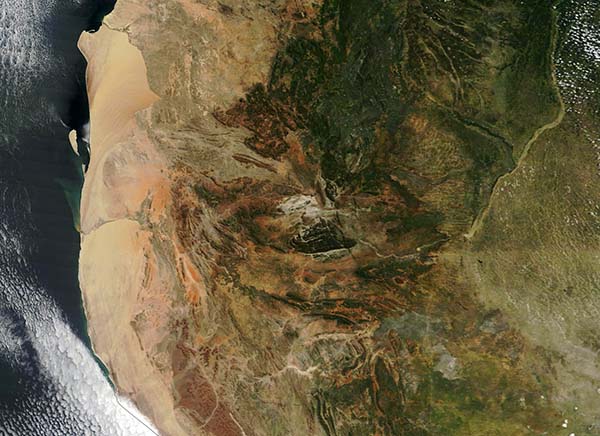Images
April 8, 2022 - Wet Season in Namibia and Angola
Tweet
On April 6, 2022, the Moderate Resolution Imaging Spectroradiometer (MODIS) on board NASA’s Terra satellite acquired a true-color image of the stunning, rugged landscape of southwestern Africa near the end of the wet season. The contrasts in landforms and ecosystems are stark in both southwestern Angola and northwestern Namibia. Along the South Atlantic coast, the bone-dry and supremely sand-filled Namib Desert merges with Angola’s Kaokoveld Desert to create a vast swath of camel-colored tan. Moving inland, a wash of green marks the moister regions of a rapidly-rising escarpment, topped with dark brown and ochre rocky outcroppings. Further north rich greens mark heavier vegetation—and an ecosystem that does not strictly rely on the rainy season to coax vegetation into existence as happens in the drier locations.
A sinuous green line splits the coastal desert in two as it drops from the Angolan escarpment to reach the South Atlantic Ocean. This is the Kunene River (Cunene River), which rises from the highlands in Angola and flows southward to the border with Namibia. There it turns westward, creating a green oasis along its banks as well as marking the border between Angola (north) and Namibia. The Kunene, which appears full and vibrant in this rainy-season image, is one of the very few perennial rivers in this region.
The extremely arid deserts in this region are ancient as well as inhospitable. Despite their extreme temperatures and almost complete lack of moisture year-round, they are fascinating places. Much of these deserts have been preserved as national parks, not only for their human history but especially because the ecosystems found here support unique species of plants, reptiles, bird, marine life, and mammals.
Iona National Park sits at the northern tip of the Namib Desert in southwestern Angola. This special section of the Namib is known as the Moçâmedes Desert and is said to be the oldest desert in the world. Iona National Park is one of the largest parks in Angola, and, when combined with the Namib-Naukluft National Park in Namibia, is also part of the largest trans-frontier conservation areas in the world. This conservation area has high endemism, with many of the reptiles, plant, and bird species found only here. Some interesting species include the South African oryx, springbuck, Hartmann’s zebra, ostrich, cheetah, leopard, and brown hyena. Iona National Park has been recognized at an “Important Bird Area” by BirdLife International, with more than 150 species identified.
Image Facts
Satellite:
Terra
Date Acquired: 4/6/2022
Resolutions:
1km (62.9 KB), 500m (158 KB), 250m (349 KB)
Bands Used: 1,4,3
Image Credit:
MODIS Land Rapid Response Team, NASA GSFC
Tweet
On April 6, 2022, the Moderate Resolution Imaging Spectroradiometer (MODIS) on board NASA’s Terra satellite acquired a true-color image of the stunning, rugged landscape of southwestern Africa near the end of the wet season. The contrasts in landforms and ecosystems are stark in both southwestern Angola and northwestern Namibia. Along the South Atlantic coast, the bone-dry and supremely sand-filled Namib Desert merges with Angola’s Kaokoveld Desert to create a vast swath of camel-colored tan. Moving inland, a wash of green marks the moister regions of a rapidly-rising escarpment, topped with dark brown and ochre rocky outcroppings. Further north rich greens mark heavier vegetation—and an ecosystem that does not strictly rely on the rainy season to coax vegetation into existence as happens in the drier locations.
A sinuous green line splits the coastal desert in two as it drops from the Angolan escarpment to reach the South Atlantic Ocean. This is the Kunene River (Cunene River), which rises from the highlands in Angola and flows southward to the border with Namibia. There it turns westward, creating a green oasis along its banks as well as marking the border between Angola (north) and Namibia. The Kunene, which appears full and vibrant in this rainy-season image, is one of the very few perennial rivers in this region.
The extremely arid deserts in this region are ancient as well as inhospitable. Despite their extreme temperatures and almost complete lack of moisture year-round, they are fascinating places. Much of these deserts have been preserved as national parks, not only for their human history but especially because the ecosystems found here support unique species of plants, reptiles, bird, marine life, and mammals.
Iona National Park sits at the northern tip of the Namib Desert in southwestern Angola. This special section of the Namib is known as the Moçâmedes Desert and is said to be the oldest desert in the world. Iona National Park is one of the largest parks in Angola, and, when combined with the Namib-Naukluft National Park in Namibia, is also part of the largest trans-frontier conservation areas in the world. This conservation area has high endemism, with many of the reptiles, plant, and bird species found only here. Some interesting species include the South African oryx, springbuck, Hartmann’s zebra, ostrich, cheetah, leopard, and brown hyena. Iona National Park has been recognized at an “Important Bird Area” by BirdLife International, with more than 150 species identified.
Image Facts
Satellite:
Terra
Date Acquired: 4/6/2022
Resolutions:
1km (62.9 KB), 500m (158 KB), 250m (349 KB)
Bands Used: 1,4,3
Image Credit:
MODIS Land Rapid Response Team, NASA GSFC




